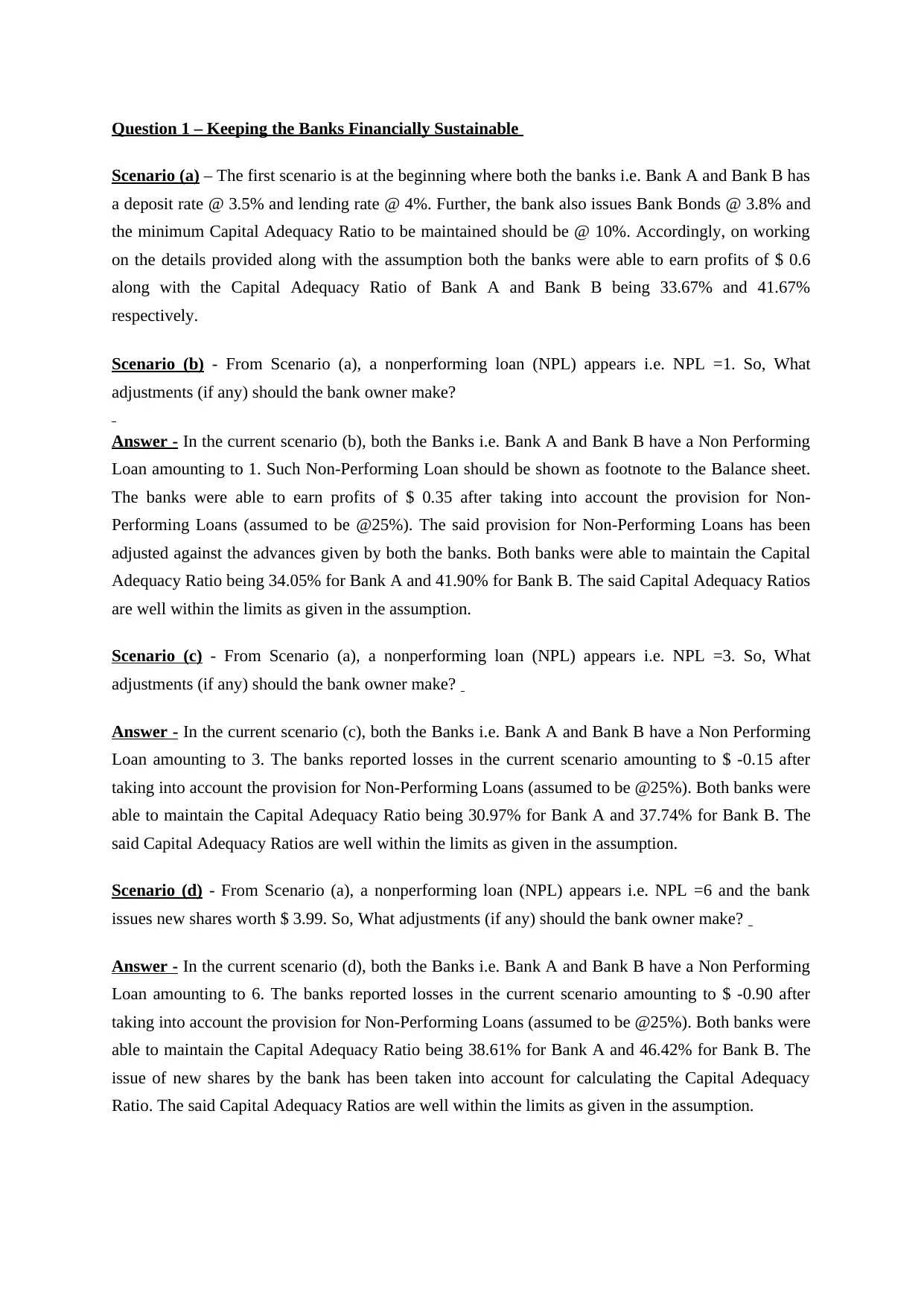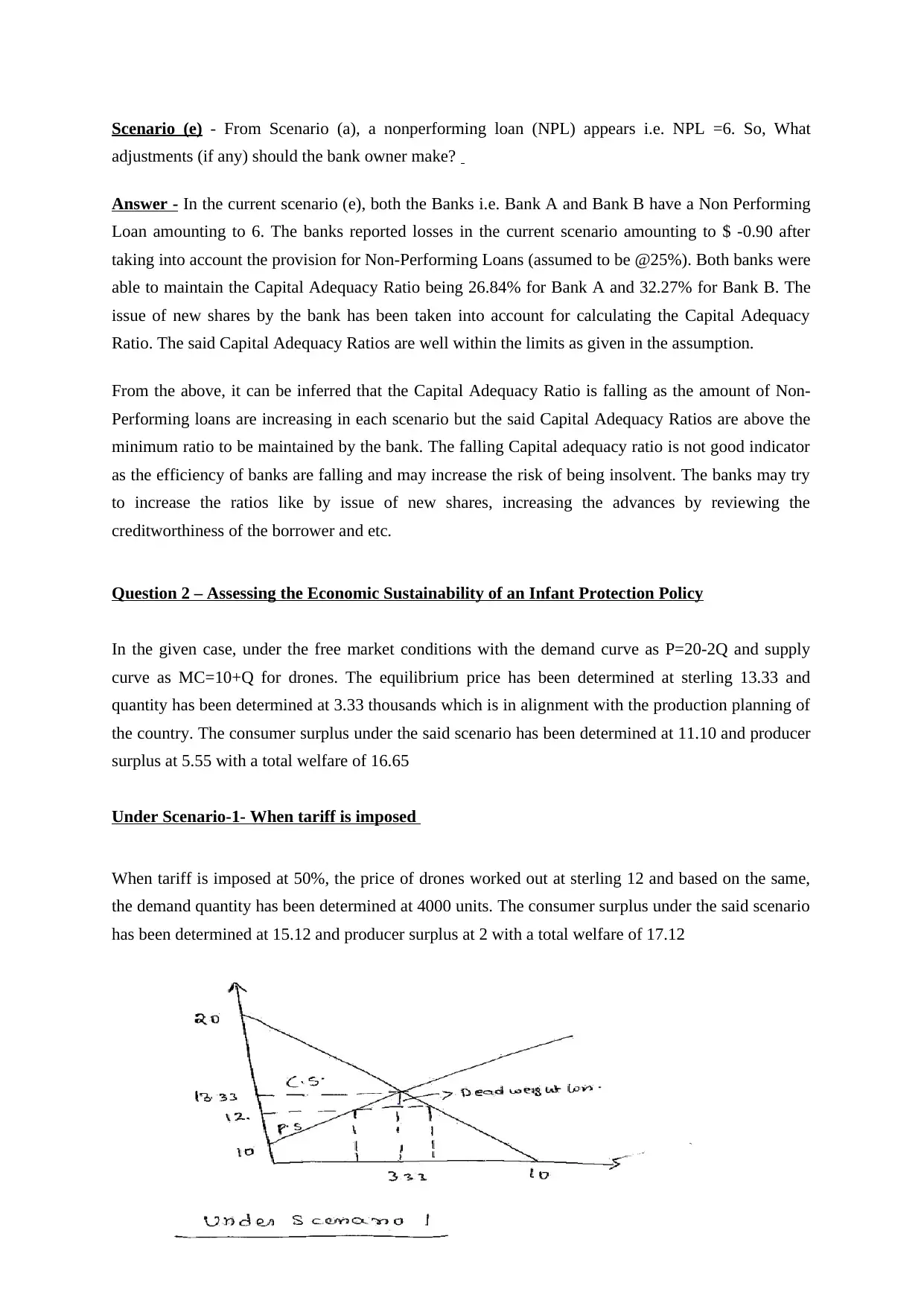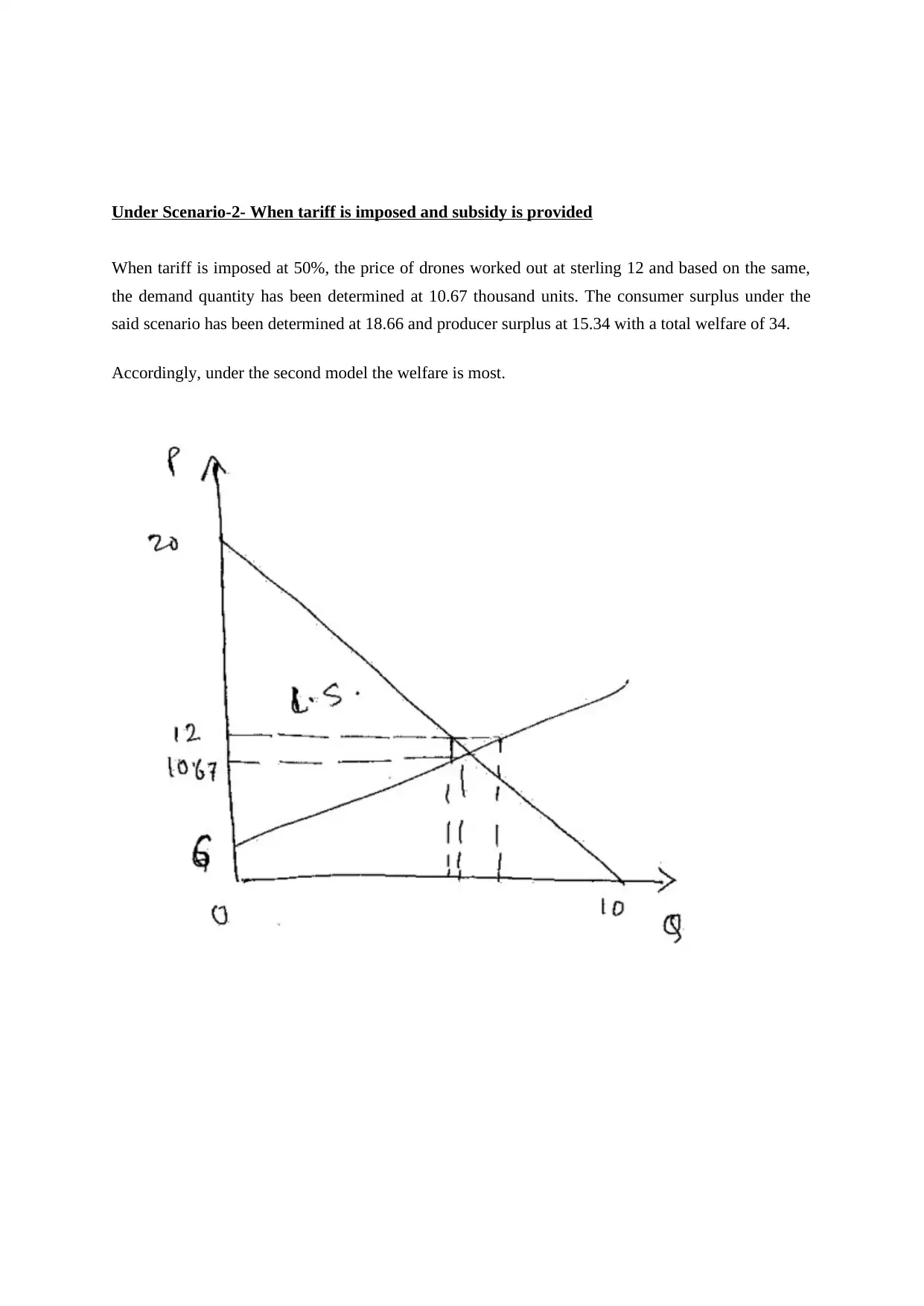Financial Sustainability Analysis: Banks and Infant Protection
VerifiedAdded on 2022/08/13
|3
|1059
|14
Homework Assignment
AI Summary
This assignment analyzes the financial sustainability of two banks (Bank A and Bank B) under various scenarios involving non-performing loans (NPLs). It assesses the impact of NPLs on the banks' capital adequacy ratios (CAR) and profitability, considering adjustments like loan loss provisions and new share issues. The assignment also examines the economic sustainability of an infant protection policy, evaluating consumer surplus, producer surplus, and total welfare under free market conditions, with tariffs, and with tariffs and subsidies. The analysis involves calculating equilibrium prices and quantities, and assessing the impact of different policy interventions on market outcomes and overall welfare. The analysis demonstrates the impact of these factors on the banks' financial health and the economic implications of different policy choices.

Question 1 – Keeping the Banks Financially Sustainable
Scenario (a) – The first scenario is at the beginning where both the banks i.e. Bank A and Bank B has
a deposit rate @ 3.5% and lending rate @ 4%. Further, the bank also issues Bank Bonds @ 3.8% and
the minimum Capital Adequacy Ratio to be maintained should be @ 10%. Accordingly, on working
on the details provided along with the assumption both the banks were able to earn profits of $ 0.6
along with the Capital Adequacy Ratio of Bank A and Bank B being 33.67% and 41.67%
respectively.
Scenario (b) - From Scenario (a), a nonperforming loan (NPL) appears i.e. NPL =1. So, What
adjustments (if any) should the bank owner make?
Answer - In the current scenario (b), both the Banks i.e. Bank A and Bank B have a Non Performing
Loan amounting to 1. Such Non-Performing Loan should be shown as footnote to the Balance sheet.
The banks were able to earn profits of $ 0.35 after taking into account the provision for Non-
Performing Loans (assumed to be @25%). The said provision for Non-Performing Loans has been
adjusted against the advances given by both the banks. Both banks were able to maintain the Capital
Adequacy Ratio being 34.05% for Bank A and 41.90% for Bank B. The said Capital Adequacy Ratios
are well within the limits as given in the assumption.
Scenario (c) - From Scenario (a), a nonperforming loan (NPL) appears i.e. NPL =3. So, What
adjustments (if any) should the bank owner make?
Answer - In the current scenario (c), both the Banks i.e. Bank A and Bank B have a Non Performing
Loan amounting to 3. The banks reported losses in the current scenario amounting to $ -0.15 after
taking into account the provision for Non-Performing Loans (assumed to be @25%). Both banks were
able to maintain the Capital Adequacy Ratio being 30.97% for Bank A and 37.74% for Bank B. The
said Capital Adequacy Ratios are well within the limits as given in the assumption.
Scenario (d) - From Scenario (a), a nonperforming loan (NPL) appears i.e. NPL =6 and the bank
issues new shares worth $ 3.99. So, What adjustments (if any) should the bank owner make?
Answer - In the current scenario (d), both the Banks i.e. Bank A and Bank B have a Non Performing
Loan amounting to 6. The banks reported losses in the current scenario amounting to $ -0.90 after
taking into account the provision for Non-Performing Loans (assumed to be @25%). Both banks were
able to maintain the Capital Adequacy Ratio being 38.61% for Bank A and 46.42% for Bank B. The
issue of new shares by the bank has been taken into account for calculating the Capital Adequacy
Ratio. The said Capital Adequacy Ratios are well within the limits as given in the assumption.
Scenario (a) – The first scenario is at the beginning where both the banks i.e. Bank A and Bank B has
a deposit rate @ 3.5% and lending rate @ 4%. Further, the bank also issues Bank Bonds @ 3.8% and
the minimum Capital Adequacy Ratio to be maintained should be @ 10%. Accordingly, on working
on the details provided along with the assumption both the banks were able to earn profits of $ 0.6
along with the Capital Adequacy Ratio of Bank A and Bank B being 33.67% and 41.67%
respectively.
Scenario (b) - From Scenario (a), a nonperforming loan (NPL) appears i.e. NPL =1. So, What
adjustments (if any) should the bank owner make?
Answer - In the current scenario (b), both the Banks i.e. Bank A and Bank B have a Non Performing
Loan amounting to 1. Such Non-Performing Loan should be shown as footnote to the Balance sheet.
The banks were able to earn profits of $ 0.35 after taking into account the provision for Non-
Performing Loans (assumed to be @25%). The said provision for Non-Performing Loans has been
adjusted against the advances given by both the banks. Both banks were able to maintain the Capital
Adequacy Ratio being 34.05% for Bank A and 41.90% for Bank B. The said Capital Adequacy Ratios
are well within the limits as given in the assumption.
Scenario (c) - From Scenario (a), a nonperforming loan (NPL) appears i.e. NPL =3. So, What
adjustments (if any) should the bank owner make?
Answer - In the current scenario (c), both the Banks i.e. Bank A and Bank B have a Non Performing
Loan amounting to 3. The banks reported losses in the current scenario amounting to $ -0.15 after
taking into account the provision for Non-Performing Loans (assumed to be @25%). Both banks were
able to maintain the Capital Adequacy Ratio being 30.97% for Bank A and 37.74% for Bank B. The
said Capital Adequacy Ratios are well within the limits as given in the assumption.
Scenario (d) - From Scenario (a), a nonperforming loan (NPL) appears i.e. NPL =6 and the bank
issues new shares worth $ 3.99. So, What adjustments (if any) should the bank owner make?
Answer - In the current scenario (d), both the Banks i.e. Bank A and Bank B have a Non Performing
Loan amounting to 6. The banks reported losses in the current scenario amounting to $ -0.90 after
taking into account the provision for Non-Performing Loans (assumed to be @25%). Both banks were
able to maintain the Capital Adequacy Ratio being 38.61% for Bank A and 46.42% for Bank B. The
issue of new shares by the bank has been taken into account for calculating the Capital Adequacy
Ratio. The said Capital Adequacy Ratios are well within the limits as given in the assumption.
Paraphrase This Document
Need a fresh take? Get an instant paraphrase of this document with our AI Paraphraser

Scenario (e) - From Scenario (a), a nonperforming loan (NPL) appears i.e. NPL =6. So, What
adjustments (if any) should the bank owner make?
Answer - In the current scenario (e), both the Banks i.e. Bank A and Bank B have a Non Performing
Loan amounting to 6. The banks reported losses in the current scenario amounting to $ -0.90 after
taking into account the provision for Non-Performing Loans (assumed to be @25%). Both banks were
able to maintain the Capital Adequacy Ratio being 26.84% for Bank A and 32.27% for Bank B. The
issue of new shares by the bank has been taken into account for calculating the Capital Adequacy
Ratio. The said Capital Adequacy Ratios are well within the limits as given in the assumption.
From the above, it can be inferred that the Capital Adequacy Ratio is falling as the amount of Non-
Performing loans are increasing in each scenario but the said Capital Adequacy Ratios are above the
minimum ratio to be maintained by the bank. The falling Capital adequacy ratio is not good indicator
as the efficiency of banks are falling and may increase the risk of being insolvent. The banks may try
to increase the ratios like by issue of new shares, increasing the advances by reviewing the
creditworthiness of the borrower and etc.
Question 2 – Assessing the Economic Sustainability of an Infant Protection Policy
In the given case, under the free market conditions with the demand curve as P=20-2Q and supply
curve as MC=10+Q for drones. The equilibrium price has been determined at sterling 13.33 and
quantity has been determined at 3.33 thousands which is in alignment with the production planning of
the country. The consumer surplus under the said scenario has been determined at 11.10 and producer
surplus at 5.55 with a total welfare of 16.65
Under Scenario-1- When tariff is imposed
When tariff is imposed at 50%, the price of drones worked out at sterling 12 and based on the same,
the demand quantity has been determined at 4000 units. The consumer surplus under the said scenario
has been determined at 15.12 and producer surplus at 2 with a total welfare of 17.12
adjustments (if any) should the bank owner make?
Answer - In the current scenario (e), both the Banks i.e. Bank A and Bank B have a Non Performing
Loan amounting to 6. The banks reported losses in the current scenario amounting to $ -0.90 after
taking into account the provision for Non-Performing Loans (assumed to be @25%). Both banks were
able to maintain the Capital Adequacy Ratio being 26.84% for Bank A and 32.27% for Bank B. The
issue of new shares by the bank has been taken into account for calculating the Capital Adequacy
Ratio. The said Capital Adequacy Ratios are well within the limits as given in the assumption.
From the above, it can be inferred that the Capital Adequacy Ratio is falling as the amount of Non-
Performing loans are increasing in each scenario but the said Capital Adequacy Ratios are above the
minimum ratio to be maintained by the bank. The falling Capital adequacy ratio is not good indicator
as the efficiency of banks are falling and may increase the risk of being insolvent. The banks may try
to increase the ratios like by issue of new shares, increasing the advances by reviewing the
creditworthiness of the borrower and etc.
Question 2 – Assessing the Economic Sustainability of an Infant Protection Policy
In the given case, under the free market conditions with the demand curve as P=20-2Q and supply
curve as MC=10+Q for drones. The equilibrium price has been determined at sterling 13.33 and
quantity has been determined at 3.33 thousands which is in alignment with the production planning of
the country. The consumer surplus under the said scenario has been determined at 11.10 and producer
surplus at 5.55 with a total welfare of 16.65
Under Scenario-1- When tariff is imposed
When tariff is imposed at 50%, the price of drones worked out at sterling 12 and based on the same,
the demand quantity has been determined at 4000 units. The consumer surplus under the said scenario
has been determined at 15.12 and producer surplus at 2 with a total welfare of 17.12

Under Scenario-2- When tariff is imposed and subsidy is provided
When tariff is imposed at 50%, the price of drones worked out at sterling 12 and based on the same,
the demand quantity has been determined at 10.67 thousand units. The consumer surplus under the
said scenario has been determined at 18.66 and producer surplus at 15.34 with a total welfare of 34.
Accordingly, under the second model the welfare is most.
When tariff is imposed at 50%, the price of drones worked out at sterling 12 and based on the same,
the demand quantity has been determined at 10.67 thousand units. The consumer surplus under the
said scenario has been determined at 18.66 and producer surplus at 15.34 with a total welfare of 34.
Accordingly, under the second model the welfare is most.
⊘ This is a preview!⊘
Do you want full access?
Subscribe today to unlock all pages.

Trusted by 1+ million students worldwide
1 out of 3
Related Documents
Your All-in-One AI-Powered Toolkit for Academic Success.
+13062052269
info@desklib.com
Available 24*7 on WhatsApp / Email
![[object Object]](/_next/static/media/star-bottom.7253800d.svg)
Unlock your academic potential
Copyright © 2020–2025 A2Z Services. All Rights Reserved. Developed and managed by ZUCOL.




